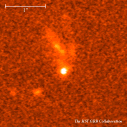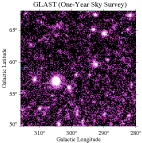Imagine the Universe! News Desk
Hidden Gamma Rays Sources to be Exposed!
GLAST Scientists Plan to Investigate
Some of the Most Violent Events in the Universe
[Update: GLAST launched on June 11, 2008.]
| 14 March 2000 |
The universe is a violent place. Stars explode. Galaxies collide. Gas and dust spin around black holes at incredible velocities until the black holes devour it all. Recent space telescope missions have given scientists a glimpse into the nature of these violent events and energetic objects. "GLAST" will give them a much better look.
 An artists conception of GLAST in orbit |
"GLAST" stands for Gamma Ray Large Area Space Telescope. NASA recently announced that it has selected a collaborative, international team to lead the research. NASA plans to launch the satellite in 2005. The Fermi mission will be managed by the NASA Goddard Space Flight Center. The new space telescope will capture images of these objects' gamma ray emissions, the highest energy electromagnetic radiation in the universe. Gamma radiation has 10,000 times more energy than visible light. The GLAST satellite will be 30 to 50 times more sensitive than the EGRET satellite, an instrument aboard the Compton Gamma Ray Observatory (CGRO). GLAST will also have a field of view that's twice as large, allowing scientists to view larger objects at much higher resolution than ever before.
It takes extremely violent events or energetic objects to create gamma radiation. GLAST will explore these gamma ray emissions in a quest to find the source of these massive amounts of energy. Objects explored will include pulsars, distant galaxies with super-massive black holes at their center (known as active galaxies or active galactic nuclei), neutron stars, individual black holes, exploded stars, and other objects and events at the extremes of mass and energy.
 An artist's conception of an active galactic nucleus, with jets of high energy particles emanating from the center |
Scientists hope to observe at least ten times as many active galactic nuclei and black holes as they've been able to see in the gamma ray band so far. Earlier gamma ray telescopes have not been able to determine the exact source of some gamma rays. GLAST's higher resolution and improved timing ability should help resolve gamma ray sources, and may help connect these sources to known objects. Currently, about half the objects known to produce gamma rays have not been connected with celestial objects seen at other wavelengths. Scientists hope to use GLAST to make those connections, and to study objects that cannot be connected with other known objects.
By studying massive celestial objects, scientists also hope to use GLAST to gain a better understanding of the acceleration of tiny particles of matter, including electrons, positrons, protons, and pions. Gamma rays are usually created by the interaction of these high-energy particles.

Hubble Space Telescope image |
The GLAST mission will also explore gamma bursts-- short, intense, unexplained bursts of energy at very short wavelengths. Even the dimmest of these bursts is as bright as the brightest of the steady, high-energy gamma ray sources. GLAST's improvements in sensitivity and precision will provide an opportunity for new discoveries as well. One possibility is the search for dark matter, the "invisible" matter which may be mostly responsible for gravitationally holding pieces of the universe together.
NASA recently selected the research studies that GLAST will perform. The primary study is entitled, GLAST Large Area Telescope Flight Investigation: A Particle-Astrophysics Partnership to Explore the High-Energy Universe. The study is a collaborative international effort involving major contributions from the U.S. Department of Energy, and contributions from France, Italy, Japan, Sweden and the University of Washington. The primary study will be lead by Prof. Peter Michelson of Stanford University.

 A comparison of the resolution of the current EGRET instrument and the expected resolution of GLAST. An actual image of Virgo region from EGRET is shown at left. A simulated GLAST image of the same Virgo region is shown at right. |
Other GLAST studies will include observations of pulsars by Stephen Thorsett of the University of California at Santa Cruz. A project by Professor Brenda Dingus of the University of Wisconsin will monitor the entire sky at high energies for transient events such as gamma-ray bursts or flaring quasars, so the object may be observed simultaneously at many wavelengths to obtain the most information possible. Dr. Martin Pohl of Ruhr University in Bochum, Germany, will model diffuse gamma ray emissions to aid in the analysis of GLAST data. And a study by Dr. Charles Dermer of the U.S. Naval Research Laboratory will explore techniques for analysis and modeling for other GLAST studies.
Update (3/14/2000):
NASA recently announced another addition to the GLAST mission. The Gamma-Ray Burst Monitor (GBM) instrument will watch the skies for elusive, short-lived gamma-ray bursts. Together with the main GLAST instrument, The Gamma-Ray Burst Monitor will watch for gamma ray bursts at the widest range of wavelengths ever possible on a single spacecraft. The GBM investigation will include the efforts of scientist and engineers from NASA's Marshall Space Flight Center, the Max Planck Institute for Extraterrestrial Physics in Germany, and the University of Alabama in Huntsville.

